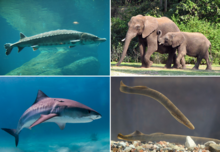| Vertebrate | |
|---|---|

| |
| Example of vertebrates: Acipenser oxyrinchus (Actinopterygii), an African bush elephant (Tetrapoda), a Tiger shark (Chondrichthyes) and a River lamprey (Agnatha). | |
| Scientific classification | |
| Kingdom: | Animalia |
| Superphylum: | Deuterostomia |
| Phylum: | Chordata |
| Clade: | Olfactores |
| Subphylum: | Vertebrata J-B. Lamarck, 1801[2] |
| Infraphylums | |
| Synonyms | |
|
Ossea Batsch, 1788[2] | |
Vertebrates (/ˈvɜːrtəbrɪts, -ˌbreɪts/)[3] comprise all animal taxa within the subphylum Vertebrata (/ˌvɜːrtəˈbreɪtə/)[4] (chordates with backbones), including all mammals, birds, reptiles, amphibians, and fish. Vertebrates represent the overwhelming majority of the phylum Chordata, with currently about 69,963 species described.[5] Vertebrates comprise such groups as the following:
- jawless fish, which include hagfish and lampreys
- jawed vertebrates, which include:
- cartilaginous fish (sharks, rays, and ratfish)
- bony vertebrates, which include:
Extant vertebrates range in size from the frog species Paedophryne amauensis, at as little as 7.7 mm (0.30 in), to the blue whale, at up to 33 m (108 ft). Vertebrates make up less than five percent of all described animal species; the rest are invertebrates, which lack vertebral columns.
The vertebrates traditionally include the hagfish, which do not have proper vertebrae due to their loss in evolution,[6] though their closest living relatives, the lampreys, do.[7] Hagfish do, however, possess a cranium. For this reason, the vertebrate subphylum is sometimes referred to as "Craniata" when discussing morphology. Molecular analysis since 1992 has suggested that hagfish are most closely related to lampreys,[8] and so also are vertebrates in a monophyletic sense. Others consider them a sister group of vertebrates in the common taxon of craniata.[9]
https://en.wikipedia.org/wiki/Vertebrate
No comments:
Post a Comment